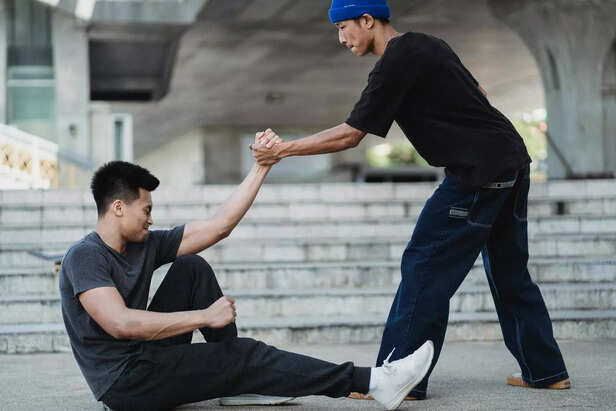It’s Okay to Break, Just Don’t Stay Broken (Strength is Beyond Suffering) - Bhagavad Gita
Riya Kumari | May 02, 2025, 23:55 IST
( Image credit : Times Life Bureau )
Life? It’s messy. It’s like that scene in a romcom where everything falls apart just before the big ‘I love you’ moment. You know, when the heroine is standing in the rain with mascara running down her face, looking like she just got hit by a truck of emotional baggage. That’s us, 90% of the time—broken, overwhelmed, questioning if the universe really has it out for us. But here’s the plot twist—it’s okay to break. Yep, you heard me. You don’t have to play superhero all the time, even if your Instagram feed suggests otherwise.
We all have that moment. The one where everything falls apart, where the weight of life’s challenges threatens to crush you. It’s the kind of moment when you question if you’ll ever be the same. Maybe it’s a loss, a betrayal, or just the relentless grind of everyday life. We’ve all been there—feeling as if we’ve shattered into a thousand pieces, wondering if we'll ever make sense of it all. Here’s the thing no one tells you: it’s okay to break. It’s okay to be vulnerable, to feel overwhelmed, to question your strength. What matters, however, is what you do after you break. Do you stay broken, or do you find the strength to rebuild? The Bhagavad Gita, a text that has been guiding people through life’s storms for centuries, has a simple but profound message: Strength is not about avoiding pain; it’s about learning how to rise after experiencing it. This wisdom, while ancient, is timeless—and it’s something that’s needed now more than ever.

In the Bhagavad Gita, Arjuna, the warrior prince, stands on the battlefield ready to fight, but he’s frozen by doubt and grief. He’s overwhelmed by the weight of his responsibilities and the pain of what’s coming. He looks around, sees his loved ones, his teachers, his friends, all on opposite sides of the battle, and he can’t move. In that moment, he feels broken, utterly consumed by the turmoil inside. But here’s what Krishna, his charioteer and spiritual guide, tells him: It’s okay to feel this way. It’s okay to be overwhelmed. Pain is a part of the journey. What matters is how you rise from it.
Krishna’s message isn’t just about enduring suffering—it’s about transcending it. The key is not to let suffering define you, but to use it as a means of growth. The Gita doesn’t paint a picture of strength as a constant, unyielding force. True strength, according to Krishna, comes from acknowledging our vulnerabilities and still choosing to move forward. We break. We hurt. But we don’t have to stay broken.

We live in a world that often tells us to "push through," to "keep going," to "not show weakness." There’s this constant pressure to be unshakable, like we’re supposed to rise above everything without ever truly feeling the weight of it all. But life doesn’t work like that, does it? You’ve probably heard someone say, "You’re stronger than you think." But let’s be honest, when you’re at your lowest, those words often feel hollow. What does strength even look like when you’re not sure if you can get out of bed?
The truth is, strength isn’t about power or endurance in the way we’ve been taught. Strength is not about never being vulnerable or never having a moment of doubt. Strength is about having the courage to admit when you’re broken—and the resolve to find your way back to wholeness. That’s where the wisdom of the Gita comes in. Strength, as Krishna teaches Arjuna, is about the choice to rise again. It’s about understanding that every moment of pain, every moment of weakness, is an opportunity to redefine who you are, to rebuild yourself from a more honest place.

We often see suffering as a waste—something that should be avoided at all costs. We look at pain and grief as roadblocks to happiness, to success, to peace. But what if suffering wasn’t the enemy? What if it was just part of the process? The Bhagavad Gita doesn't promise that we won’t suffer. It acknowledges that suffering is inevitable in this world. But it also offers something incredibly valuable: a way to transform that suffering into wisdom, into strength, into purpose.
Consider the times when you've been through something difficult—maybe it’s been a heartbreak, a loss, a failure. In those moments, you might have felt like life had no meaning, like nothing would ever make sense again. But when you look back, don’t you see how those moments shaped you? How they taught you something about yourself? How they forced you to confront your weaknesses and, in the process, discover your true strength? That’s the essence of the Gita’s teaching: Suffering isn’t the end of the story. It’s just the beginning of a new chapter. And it’s up to you how you choose to write that chapter. Do you let the pain define your narrative, or do you use it to deepen your understanding of who you are and what you’re capable of?

I want you to think about your own life for a moment. What have you been through? What has broken you? And more importantly—what have you learned from it? The moments when we’ve been broken are often the moments when we’ve learned our most valuable lessons. They’re the times when we’ve had to get creative with how we put ourselves back together, when we’ve had to find new ways to be whole.
The Gita teaches that you don’t have to be flawless to be strong. In fact, your flaws—the very things you think make you weak—are often where your greatest strengths lie. The key is in how you approach the struggle. Do you let it consume you, or do you choose to grow through it? It’s easy to get stuck in a cycle of self-pity or resentment when things go wrong. It’s tempting to stay in the brokenness, to hold on to the pain, to let it become a part of your identity. But the real power lies in the ability to rise, not despite your pain, but through it.
So, what does all of this mean for you, today, right now? It means that it’s okay to break. It means that in those moments when you feel lost, when you feel like nothing is going right, you don’t have to pretend to be fine. You don’t have to "keep it together" at all costs. The Gita doesn’t demand perfection—it simply invites you to remember that you have the power to heal, to rebuild, and to rise.
Strength, as the Gita teaches, isn’t found in avoiding pain. It’s found in how you navigate it. It’s in the decision to stand back up, no matter how many times you fall. Strength is not about being unbreakable—it’s about being willing to break, to learn, and then to grow. The path to true strength isn’t through endless struggle or sacrifice. It’s through embracing life as it is—with all its brokenness, its beauty, and its opportunity for growth. And in that acceptance, you’ll find the strength to rebuild, again and again, until you’re whole.
Breaking Doesn't Mean Defeat—It’s the Start of Your Rebirth

Cry
( Image credit : Pexels )
In the Bhagavad Gita, Arjuna, the warrior prince, stands on the battlefield ready to fight, but he’s frozen by doubt and grief. He’s overwhelmed by the weight of his responsibilities and the pain of what’s coming. He looks around, sees his loved ones, his teachers, his friends, all on opposite sides of the battle, and he can’t move. In that moment, he feels broken, utterly consumed by the turmoil inside. But here’s what Krishna, his charioteer and spiritual guide, tells him: It’s okay to feel this way. It’s okay to be overwhelmed. Pain is a part of the journey. What matters is how you rise from it.
Krishna’s message isn’t just about enduring suffering—it’s about transcending it. The key is not to let suffering define you, but to use it as a means of growth. The Gita doesn’t paint a picture of strength as a constant, unyielding force. True strength, according to Krishna, comes from acknowledging our vulnerabilities and still choosing to move forward. We break. We hurt. But we don’t have to stay broken.
The Strength to Rise: It’s in the Choice You Make After Falling

Get up
( Image credit : Pexels )
We live in a world that often tells us to "push through," to "keep going," to "not show weakness." There’s this constant pressure to be unshakable, like we’re supposed to rise above everything without ever truly feeling the weight of it all. But life doesn’t work like that, does it? You’ve probably heard someone say, "You’re stronger than you think." But let’s be honest, when you’re at your lowest, those words often feel hollow. What does strength even look like when you’re not sure if you can get out of bed?
The truth is, strength isn’t about power or endurance in the way we’ve been taught. Strength is not about never being vulnerable or never having a moment of doubt. Strength is about having the courage to admit when you’re broken—and the resolve to find your way back to wholeness. That’s where the wisdom of the Gita comes in. Strength, as Krishna teaches Arjuna, is about the choice to rise again. It’s about understanding that every moment of pain, every moment of weakness, is an opportunity to redefine who you are, to rebuild yourself from a more honest place.
The Wisdom in Suffering: Turning Pain into Purpose

Fight back
( Image credit : Pexels )
We often see suffering as a waste—something that should be avoided at all costs. We look at pain and grief as roadblocks to happiness, to success, to peace. But what if suffering wasn’t the enemy? What if it was just part of the process? The Bhagavad Gita doesn't promise that we won’t suffer. It acknowledges that suffering is inevitable in this world. But it also offers something incredibly valuable: a way to transform that suffering into wisdom, into strength, into purpose.
Consider the times when you've been through something difficult—maybe it’s been a heartbreak, a loss, a failure. In those moments, you might have felt like life had no meaning, like nothing would ever make sense again. But when you look back, don’t you see how those moments shaped you? How they taught you something about yourself? How they forced you to confront your weaknesses and, in the process, discover your true strength? That’s the essence of the Gita’s teaching: Suffering isn’t the end of the story. It’s just the beginning of a new chapter. And it’s up to you how you choose to write that chapter. Do you let the pain define your narrative, or do you use it to deepen your understanding of who you are and what you’re capable of?
Don’t Stay Broken: Reclaim Your Power

Meditate
( Image credit : Pexels )
I want you to think about your own life for a moment. What have you been through? What has broken you? And more importantly—what have you learned from it? The moments when we’ve been broken are often the moments when we’ve learned our most valuable lessons. They’re the times when we’ve had to get creative with how we put ourselves back together, when we’ve had to find new ways to be whole.
The Gita teaches that you don’t have to be flawless to be strong. In fact, your flaws—the very things you think make you weak—are often where your greatest strengths lie. The key is in how you approach the struggle. Do you let it consume you, or do you choose to grow through it? It’s easy to get stuck in a cycle of self-pity or resentment when things go wrong. It’s tempting to stay in the brokenness, to hold on to the pain, to let it become a part of your identity. But the real power lies in the ability to rise, not despite your pain, but through it.
The Choice to Heal
Strength, as the Gita teaches, isn’t found in avoiding pain. It’s found in how you navigate it. It’s in the decision to stand back up, no matter how many times you fall. Strength is not about being unbreakable—it’s about being willing to break, to learn, and then to grow. The path to true strength isn’t through endless struggle or sacrifice. It’s through embracing life as it is—with all its brokenness, its beauty, and its opportunity for growth. And in that acceptance, you’ll find the strength to rebuild, again and again, until you’re whole.
